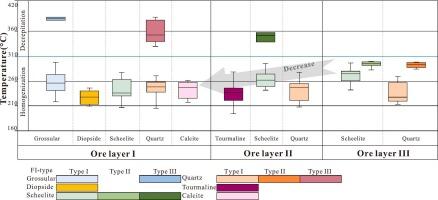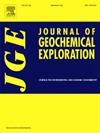Fluid inclusions and H–O isotopes of the super-large Nanyangtian tungsten deposit in southeastern Yunnan, southwestern China
IF 3.4
2区 地球科学
Q1 GEOCHEMISTRY & GEOPHYSICS
引用次数: 0
Abstract
The Nanyangtian deposit is a super-large reduced skarn tungsten deposit located in the Laojunshan W![]() Sn polymetallic ore province in southeastern Yunnan (SW China). The deposit is represented by three flat-lying mineralized zones formed vertically by the replacement of limestone or minor calcareous schist. The tungsten orebodies are mainly stratiform, lenticular, and vein types, hosted in the Paleoproterozoic Nanyangtian Formation. Three mineral formation stages have been identified based on the mineral assemblages and vein crosscutting relationships (pre-, syn-, and post-ore). The Nanyangtian is a calcic skarn deposit, dominated by a grossular-diopside-tremolite-actinolite assemblage. Scheelite, pyrrhotite, pyrite, and chalcopyrite are the main ore minerals. Detailed petrographic observations show three types of fluid inclusions (FIs) in various hydrothermal minerals: liquid-rich two-phase (type-I), gas-rich two-phase (type-II), daughter mineral-bearing three-phase (type-III). Their homogenization temperatures (193–298 °C) and salinities (1.2–9.3 wt% NaCl eq.) indicate that the Nanyangtian ore-forming fluids were of medium to low temperature and low salinity compared to the statistical data from representative skarn tungsten deposits in South China. Laser Raman microprobe analysis of the FIs shows that the inclusions are dominated by H2O with minor CH4 and N2. The δD values (relative to Vienna-Standard Mean Ocean Water, VSMOW) of fluid inclusions and calculated δ18Owater values (relative to VSMOW) of the fluids in equilibrium with hydrothermal minerals are −105 to −69 ‰ and − 1.9 to 7.6 ‰, respectively. These oxygen–hydrogen isotopic compositions indicate that the ore-forming fluids were magmatic-derived, which may have metasomatized the Nanyangtian Formation carbonaceous calcareous rocks along interlayer structures to form the prograde skarn minerals. Then the fluids mixed with meteoric water migrated along faults to form the retrograde skarn and tungsten ore. Mixing of magmatic fluid with meteoric water is likely the main factor for the ore precipitation at Nanyangtian.
Sn polymetallic ore province in southeastern Yunnan (SW China). The deposit is represented by three flat-lying mineralized zones formed vertically by the replacement of limestone or minor calcareous schist. The tungsten orebodies are mainly stratiform, lenticular, and vein types, hosted in the Paleoproterozoic Nanyangtian Formation. Three mineral formation stages have been identified based on the mineral assemblages and vein crosscutting relationships (pre-, syn-, and post-ore). The Nanyangtian is a calcic skarn deposit, dominated by a grossular-diopside-tremolite-actinolite assemblage. Scheelite, pyrrhotite, pyrite, and chalcopyrite are the main ore minerals. Detailed petrographic observations show three types of fluid inclusions (FIs) in various hydrothermal minerals: liquid-rich two-phase (type-I), gas-rich two-phase (type-II), daughter mineral-bearing three-phase (type-III). Their homogenization temperatures (193–298 °C) and salinities (1.2–9.3 wt% NaCl eq.) indicate that the Nanyangtian ore-forming fluids were of medium to low temperature and low salinity compared to the statistical data from representative skarn tungsten deposits in South China. Laser Raman microprobe analysis of the FIs shows that the inclusions are dominated by H2O with minor CH4 and N2. The δD values (relative to Vienna-Standard Mean Ocean Water, VSMOW) of fluid inclusions and calculated δ18Owater values (relative to VSMOW) of the fluids in equilibrium with hydrothermal minerals are −105 to −69 ‰ and − 1.9 to 7.6 ‰, respectively. These oxygen–hydrogen isotopic compositions indicate that the ore-forming fluids were magmatic-derived, which may have metasomatized the Nanyangtian Formation carbonaceous calcareous rocks along interlayer structures to form the prograde skarn minerals. Then the fluids mixed with meteoric water migrated along faults to form the retrograde skarn and tungsten ore. Mixing of magmatic fluid with meteoric water is likely the main factor for the ore precipitation at Nanyangtian.

中国西南部云南东南部超大型南阳田钨矿床的流体包裹体和 H-O 同位素
南阳田矿床是一个超大型还原矽卡岩钨矿床,位于云南东南部的老君山 WSn 多金属矿省(中国西南部)。该矿床由三个平卧矿化带组成,这些矿化带是由石灰岩或少量钙质片岩垂直置换形成的。钨矿体主要呈层状、透镜状和脉状,赋存于古生代南阳田地层中。根据矿物组合和矿脉横切关系,确定了三个矿物形成阶段(前矿、同矿和后矿)。南阳田层是一个钙钛矿矽卡岩矿床,主要由毛玻璃-透辉石-透闪石-阳起石组成。主要矿石矿物为白钨矿、黄铁矿、黄铁矿和黄铜矿。详细的岩相观察显示,各种热液矿物中有三种类型的流体包裹体(FIs):富液两相(I型)、富气两相(II型)和子矿物三相(III型)。其均化温度(193-298 °C)和盐度(1.2-9.3 wt% NaCl当量)表明,与华南代表性矽卡岩钨矿床的统计数据相比,南洋田成矿流体属于中低温低盐度。对FIs进行的激光拉曼微探针分析表明,包裹体主要为H2O,少量为CH4和N2。流体包裹体的δD值(相对于维也纳标准平均海水)和与热液矿物平衡的流体的δ18O水计算值(相对于维也纳标准平均海水)分别为-105至-69‰和-1.9至7.6‰。这些氧氢同位素组成表明,成矿流体来源于岩浆,可能是南阳田组碳质钙质岩沿层间构造发生了变质作用,形成了原生矽卡岩矿物。然后,与陨石水混合的流体沿断层迁移,形成逆生矽卡岩和钨矿。岩浆流体与陨石水的混合可能是南阳田矿石沉淀的主要因素。
本文章由计算机程序翻译,如有差异,请以英文原文为准。
求助全文
约1分钟内获得全文
求助全文
来源期刊

Journal of Geochemical Exploration
地学-地球化学与地球物理
CiteScore
7.40
自引率
7.70%
发文量
148
审稿时长
8.1 months
期刊介绍:
Journal of Geochemical Exploration is mostly dedicated to publication of original studies in exploration and environmental geochemistry and related topics.
Contributions considered of prevalent interest for the journal include researches based on the application of innovative methods to:
define the genesis and the evolution of mineral deposits including transfer of elements in large-scale mineralized areas.
analyze complex systems at the boundaries between bio-geochemistry, metal transport and mineral accumulation.
evaluate effects of historical mining activities on the surface environment.
trace pollutant sources and define their fate and transport models in the near-surface and surface environments involving solid, fluid and aerial matrices.
assess and quantify natural and technogenic radioactivity in the environment.
determine geochemical anomalies and set baseline reference values using compositional data analysis, multivariate statistics and geo-spatial analysis.
assess the impacts of anthropogenic contamination on ecosystems and human health at local and regional scale to prioritize and classify risks through deterministic and stochastic approaches.
Papers dedicated to the presentation of newly developed methods in analytical geochemistry to be applied in the field or in laboratory are also within the topics of interest for the journal.
 求助内容:
求助内容: 应助结果提醒方式:
应助结果提醒方式:


